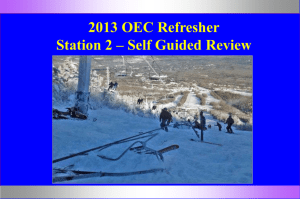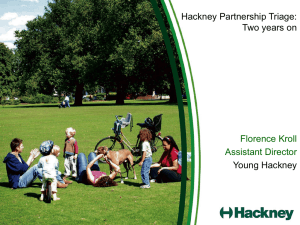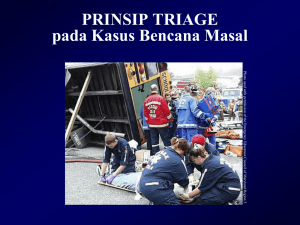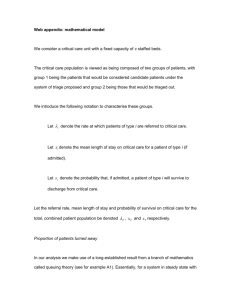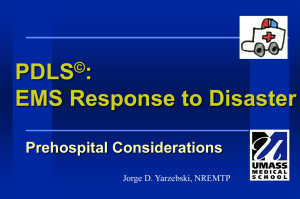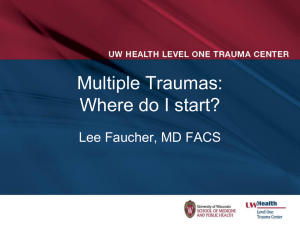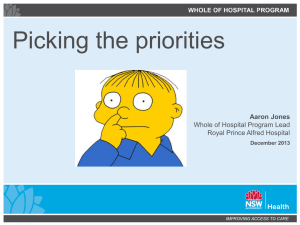SALT Triage Guidelines for 2013 Standing Orders
advertisement
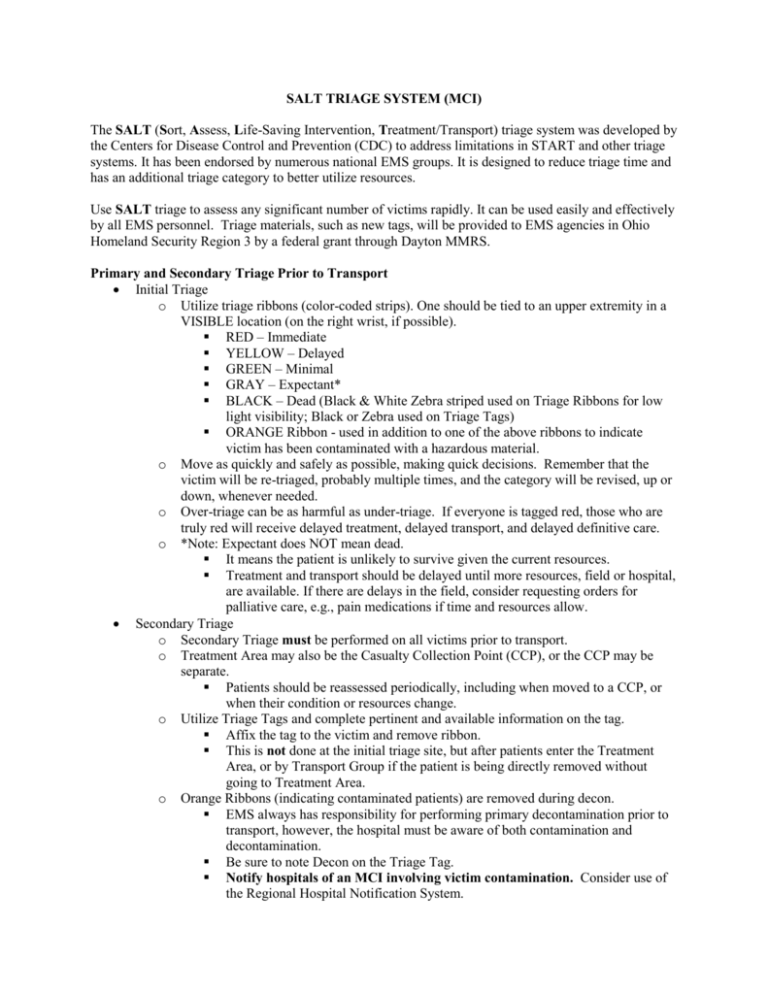
SALT TRIAGE SYSTEM (MCI) The SALT (Sort, Assess, Life-Saving Intervention, Treatment/Transport) triage system was developed by the Centers for Disease Control and Prevention (CDC) to address limitations in START and other triage systems. It has been endorsed by numerous national EMS groups. It is designed to reduce triage time and has an additional triage category to better utilize resources. Use SALT triage to assess any significant number of victims rapidly. It can be used easily and effectively by all EMS personnel. Triage materials, such as new tags, will be provided to EMS agencies in Ohio Homeland Security Region 3 by a federal grant through Dayton MMRS. Primary and Secondary Triage Prior to Transport Initial Triage o Utilize triage ribbons (color-coded strips). One should be tied to an upper extremity in a VISIBLE location (on the right wrist, if possible). RED – Immediate YELLOW – Delayed GREEN – Minimal GRAY – Expectant* BLACK – Dead (Black & White Zebra striped used on Triage Ribbons for low light visibility; Black or Zebra used on Triage Tags) ORANGE Ribbon - used in addition to one of the above ribbons to indicate victim has been contaminated with a hazardous material. o Move as quickly and safely as possible, making quick decisions. Remember that the victim will be re-triaged, probably multiple times, and the category will be revised, up or down, whenever needed. o Over-triage can be as harmful as under-triage. If everyone is tagged red, those who are truly red will receive delayed treatment, delayed transport, and delayed definitive care. o *Note: Expectant does NOT mean dead. It means the patient is unlikely to survive given the current resources. Treatment and transport should be delayed until more resources, field or hospital, are available. If there are delays in the field, consider requesting orders for palliative care, e.g., pain medications if time and resources allow. Secondary Triage o Secondary Triage must be performed on all victims prior to transport. o Treatment Area may also be the Casualty Collection Point (CCP), or the CCP may be separate. Patients should be reassessed periodically, including when moved to a CCP, or when their condition or resources change. o Utilize Triage Tags and complete pertinent and available information on the tag. Affix the tag to the victim and remove ribbon. This is not done at the initial triage site, but after patients enter the Treatment Area, or by Transport Group if the patient is being directly removed without going to Treatment Area. o Orange Ribbons (indicating contaminated patients) are removed during decon. EMS always has responsibility for performing primary decontamination prior to transport, however, the hospital must be aware of both contamination and decontamination. Be sure to note Decon on the Triage Tag. Notify hospitals of an MCI involving victim contamination. Consider use of the Regional Hospital Notification System. o Use Triage Tags with individual barcodes consistent with this Standing Order and the Ohio patient tracking system (OHTrac). Priority for transport is determined in the Treatment Area or by the Transport Group. Patient allocation, that is, distribution of patients among various hospitals, is one of EMS’ most crucial tasks. o Do not overload any hospital, regardless of transport distance to other hospitals. o In an MCI, many trauma patients will need to be transported to non-Trauma Centers. All hospitals will accept and stabilize trauma patients during MCIs. o As Transport Group assigns patient allocation, consider the likelihood that the closest hospital(s) may be overwhelmed by patients who were not transported by EMS. o In large scenarios, consider activation of the Forward Movement of Patients Plan. Forward Movement of Patients is also mentioned in the GMVEMSC Standing Orders under the heading Crisis Standards of Care in Massive Events. Full information on the process can be found in the Dayton MMRS Regional MCI Plan Template. SORT, ASSESS, LIFE-SAVING INTERVENTION, TREATMENT/TRANSPORT PROCESS S – Sort Global Sorting: Action 1 o Action: “Everyone who can hear me please move to [designated area] and we will help you” (use loud speaker if available) o Goal: Group ambulatory patients using voice commands o Result: Those who follow this command – last priority for individual assessment (Green) o Assign someone to keep them together (e.g., PD, FD, a bystander) and notify Incident Command or EMS Group/Branch of number of patients and their location. Do not forget these victims. Someone should re-triage them as soon as possible. o In smaller incidents, such as a motor vehicle crash with a few victims where you do not want any of them to move on their own, skip Action 1, and go to Global Sorting Action 2 Global Sorting: Action 2 o Action: “If you need help, wave your arm or move your leg and we will be there to help you as soon as possible” o Goal: Identify non-ambulatory patients who can follow commands or make purposeful movements o Result: Those who follow this command – second priority for individual assessment Global Sorting: Result o Casualties are now prioritized for individual assessment Priority 1: Still, and those with obvious life threat Priority 2: Waving/purposeful movements Priority 3: Walking Begin assessing all non-ambulatory victims where they lie. Each victim should be triaged as quickly as possible. Assess: 1. Is the patient breathing? o If not, open the airway. In children, consider giving two rescue breaths. o If the patient is still not breathing, label them as BLACK. Do not move the patient except to gain access to a living patient. o If patient is breathing, conduct next assessment. 2. Assess for the following: 1. Can the patient follow commands or make purposeful movements? 2. Does the patient have a peripheral pulse? 3. Is the patient not in respiratory distress? 4. Is hemorrhaging under control? If the answer to any of those questions is no and the patient IS likely to survive given current resources, tag them as RED (Immediate). If the answer to any of those questions is no and the patient is NOT likely to survive given current resources, tag them as GRAY (Expectant). If the answer to all of those questions is yes but injuries are not minor and require care, tag patient as YELLOW (Delayed). If the answers to all of those questions is yes and the injuries are minor, tag patient as GREEN (Minimal). A mnemonic for the four Assess Questions is CRAP: C – Follows Commands R – No Respiratory Distress A – No (uncontrolled) Arterial bleeding P – Peripheral Pulse Present Life Saving Interventions: Only correct life-threatening problems during triage. 1. Control major hemorrhage 2. Open airway (if child, consider giving two rescue breaths) 3. Needle chest decompression 4. Auto injector antidotes Treatment/Transport: 1. Transport/treatment priority is typically given to RED (Immediate), YELLOW (Delayed), then GREEN (Minimal). GRAY (Expectant) patients should be treated/transported as resources allow. 2. Patients should be reassessed periodically, including when moved to the CCP, or when their condition or resources change. Special Considerations When using Triage Tags, if the patient’s condition or the triage priority changes, indicate that on the tag. If necessary, add a new tag to identify the new triage priority, and if time permits, the reason for the change. Delayed

